I. What were the conditions and factors that transformed the WWII allies into enemies of the Cold War?
The year is 1917. An armored train has left Zurich’s main train station. Destination: Russia. Who is on board? A mastermind, a man of exile, a man who would transform Russia into the Soviet Union (USSR). His name was Vladimir Lenin.
The West had never been fond of communism or the idea that these Red Bolsheviks were trying to overthrown Czar Nicolas II. Nicolas was a bro. A cool cat that the West needed in power to maintain stability in the East. But Lenin had to mess that up. With the surrender of Russia to WWI Germany, the Russian people hit a boiling point and workers rose up in a revolution to make Russia great again. What does this have to do with the relationship the USSR had with the West after WWII? Everything. Many people do not know this, but the Czar’s military force also known as the White Army engaged the Bolshevik Red Army when the revolution began. This White Army was funded and supported logistically by Western powers including the USA (USSR major rival after WWII). Lenin and Trotsky were both staunch civilizationists. They wanted to spread communism’s greatness around the world and share their perfect ideology with everyone. But before that could be accomplished, Lenin died, and Stalin (the new guy in town) was extremely paranoid about being undermined by Western ideology. As a Statist, he believed in making Russia great again first (while screwing over everybody else including his own people) and then combating the West effectively. Trotsky was hunted down and ice picked in Mexico City in 1940 just as Stalin had finished purging his entire military administration. All who were suspected of being Western sympathizers were eliminated or imprisoned.
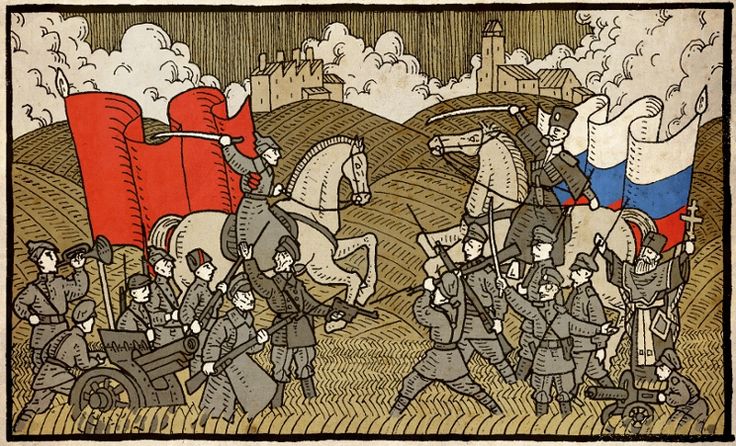
With all of this being said, ideology was a major part of the problem. Communism, Capitalism, Dictatorship, and Democracy were on the opposite sides of the economic and political spectrum. Cooperation would never seem plausible and the fact that Stalin was incredibly paranoid did nothing to help the problem. Come 1938, the West demonized Stalin for making a pact with the Devil himself (Hitler). That alone made him look even more like a threat to Western civilization. I think some historians refer to this pact as “Satan’s Alliance”.
The problem with Western policy makers is that they could not decipher who Stalin was and what his purposes were. They pictured him as erratic, dangerous, and untrustworthy. But Stalin was just playing his hand like a strategist would as Kissinger describes. Organizing the Pact with Hitler gave the USSR time to reassemble the decimated/purged Red Army and with the invasion of Poland in 39 established a buffer between him and the Nazis (later on being the West). This idea of the buffer would remain important through the ignition of the Cold War.
As WWII raged on, Nazi Germany invaded the Soviet Union in 1941. After the US joined the War in late December of that year, the USSR and Stalin had just become “allies of convenience” with the US and Roosevelt. The quote “The enemy of my enemy is my friend” could not symbolize this relationship more perfectly. Although the US hated the Russians and the Russians vice versa, they both hated the Nazis more and they were going to deal with them first before attacking each other.
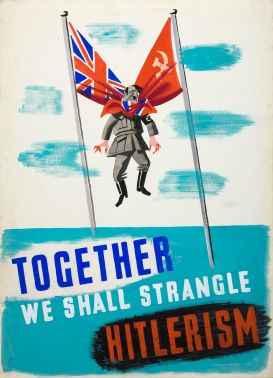
Distrust continued throughout the war. Stalin became more and more frustrated the longer the West waited to open a second front in Europe. Rightfully so, Stalin was fighting Hitler on a single front by himself. Millions of Russians were becoming bullet fodder because as Roosevelt told Stalin at the Tehran Conference: “We are not ready.” Stalin was so paranoid at the time that to make sure FDR was not lying to him, he had the embassy in Tehran bugged so he could listen in on the Western plan. A second front to Stalin’s relief was opened in June of 1944 which by this time the Soviets had turned the offensive from Stalingrad and headed west. Of course Stalin thought this was staged by the Western allies.
This idea of “allies of convenience” posed another problem. Unlike the Tripartite Alliance in WWI, the Allies of WWII did not have post war settlements established which created another controversy. At Yalta, in 1945, FDR’s poor health led him to make decisions that benefited Stalin. Stalin basically could wrap him around his finger, twirl his mustache and get what he wanted which included half of Germany and all of his holdings in Eastern Europe where he would permit “free” elections. Critics argue that Roosevelt “sold out” to the Soviets at Yalta.
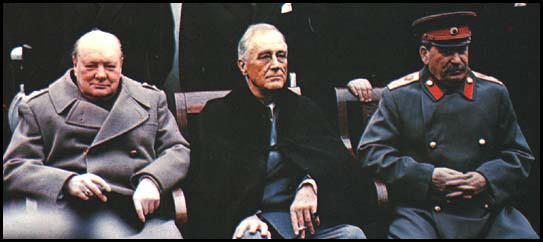 Come the end of the war in the European theater, Stalin was the only leader left among the Big Three. FDR had died in April and Churchill was voted out of office. I think this gave him a sense of power (I’m the only one left standing). At the Potsdam Conference, Stalin met with the new British PM Atley and of course the heavy hitter and hardliner Harry Truman. Truman hated everything there was to hate about communism, the USSR, and Stalin. This immediately made the situation more tense. At Potsdam, Truman got word of the success of the Manhattan Project and left knowing that the US had a weapon superior to that of the USSR and could use it as a means of leverage. What Truman did not know is that Soviet spies had infiltrated the Project as well. Stalin knew of this new super weapon and was not surprised to see it used on Japan in August of 45. Some argue that the decision to drop the bombs on Hiroshima and Nagasaki were a means of deterrence to end the war before the Soviets could lay claim in the surrender of Japan. This alone is an example of the West trying to limit Soviet expansion around the world.
Come the end of the war in the European theater, Stalin was the only leader left among the Big Three. FDR had died in April and Churchill was voted out of office. I think this gave him a sense of power (I’m the only one left standing). At the Potsdam Conference, Stalin met with the new British PM Atley and of course the heavy hitter and hardliner Harry Truman. Truman hated everything there was to hate about communism, the USSR, and Stalin. This immediately made the situation more tense. At Potsdam, Truman got word of the success of the Manhattan Project and left knowing that the US had a weapon superior to that of the USSR and could use it as a means of leverage. What Truman did not know is that Soviet spies had infiltrated the Project as well. Stalin knew of this new super weapon and was not surprised to see it used on Japan in August of 45. Some argue that the decision to drop the bombs on Hiroshima and Nagasaki were a means of deterrence to end the war before the Soviets could lay claim in the surrender of Japan. This alone is an example of the West trying to limit Soviet expansion around the world.
Stalin did not hold up the end of his agreement to hold free elections in the Soviet occupied Eastern European countries. Instead he appointed Soviet sympathizers to office in these countries, therefore, not only spreading communism, but expanding the buffer zone between the USSR and the West. With the creation and inevitable threat of NATO in 1949, and later West Germany’s entry in 1955, led to the creation of the Warsaw Pact as a means to balance the alliances between the two super powers.
The creation of the spheres of influence only worsened relations between the West and the USSR. The US was the only power that remained strong and practically untouched after the War. The industrial might pulled it out of the Depression and created a booming economy to which it would use to help rebuild Europe in the Marshall Plan. You can only imagine how Stalin felt about this extremely capitalistic plan. As a result, he ordered all Eastern European countries under Soviet control to refuse any kind of economic aid from the West. As Stalin deemed Russia secure, he began trying to use his spheres of influence to spread the communist ideology especially in Turkey and Greece for example. This was put down and controlled by the US with issue of the Truman Doctrine in 1948.
Truman was able to manipulate Stalin in the early years after WWII in which his actions can be seen as strength against oppression. The success of the Berlin Airlift for example floored Stalin as he was not able to consume all of Berlin behind his “Iron Curtain” as Churchill labeled it. Truman’s grip over Stalin would not last long as the USSR detonated their first atomic weapon in 1949.
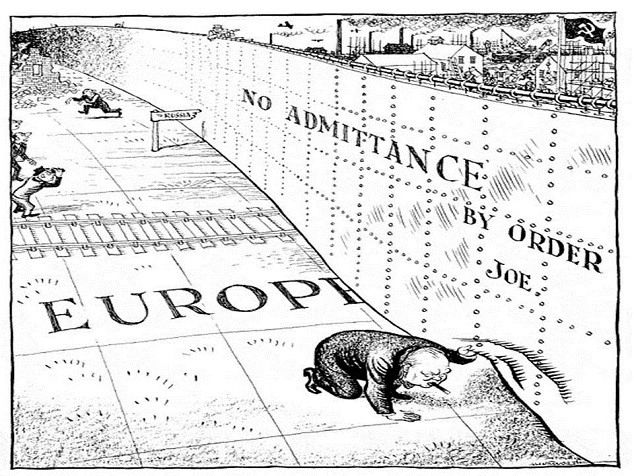
The detonation of the Soviet bomb in 1949 changed things. The USSR and the US were now on equal playing fields. Since there was no more leverage, the arms race launched to see who could have the stronger weaponry (a sign of superiority). A thus truly begins a long history of the Cold War. It was not questioned “if” there was going to be nuclear Armageddon… the question was when?
To bring this all together now, why did these allies transform into enemies?
The simple answer? They were never allies to begin with. They both shot Nazis together, but that did not mean they were friends. Hostilities since the Russian Revolution and constant clash between the two ideologies made it impossible for there to be a friendship or cooperation between the two super powers. Both wanted domination and control over the world from two very different perspectives. The US wanted to spread democracy, freedom, liberty, and capitalism to all. They wanted to give everyone an opportunity to become something better. This idea of Manifest Destiny and spreading the American Dream through economic freedom was true even if some countries did not want it like North Vietnam for example. The USSR wanted to spread socialism and communism. They emphasized realist power and fear as the tools of success. Leaders should be ruthless and strict in their faith to communism/socialism. And for some, Stalin was successful. China under Mao created his own version of socialism as well as North Korea who is still a threat today.
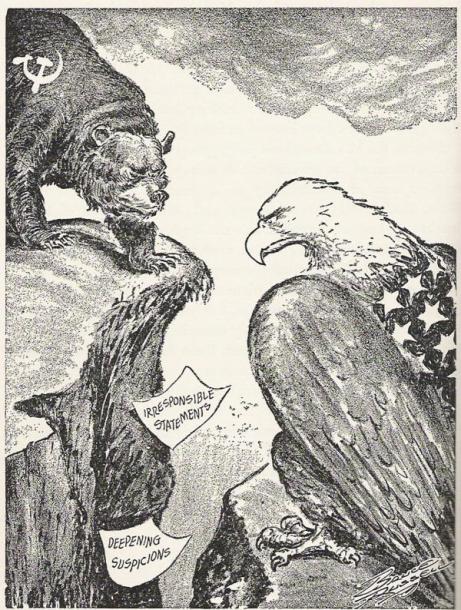
These “allies” became enemies because there was no one worse to fight. They both deemed each other their worst enemy. It was a power struggle over which ideology was superior. Proxies were fought all over the globe to prove this: Korea, Vietnam, Israel, among others. Stalin was blinded by realist power and the desire to create the world’s destiny under the hammer and sickle. Forcing people to change their belief through violence, fear, destruction would not work. The ruins that lay behind the Iron Curtain prove this. The revolts against the Soviet Union prove this. Berlin as a divided city symbolizes this. The Berlin wall and “No Man’s Land” demonstrate this.
I will admit that without Soviet support in WWII, the outcome would have been very different. If Hitler had respected the Pact and they remained neutral allies, the US would have severely struggled. The hate for Nazism and Fascism drove deep into both the hearts of Americans and Soviets which is why we were probably more like “associates” or “soldiers in arms”. The competition between Liberalism and Socialism was to be decided and with the collapse of the USSR in 1989, Liberalism and democracy was victorious. The economic and political instability that is created through socialism and communism created chaos and an untimely demise for the USSR. It is important to note that “history has not ended” as Fukuyama argued. I offer a quote from JFK.
“A man may die, nations may rise and fall, but an idea lives on. Ideas have endurance without death.”
John F. Kennedy, December 14, 1962.
Socialism and Communism still survive the Cold War and we must be vigilant not to let us go to war again.
“The threat of a world war is no more.”
Mikhail Gorbachev, farewell speech signifying the end of the USSR and the Cold War, December 1991.
As long as we do not allow greed and selfishness get the best of us. Some may argue that a new Cold War is emerging from the tensions between Putin and Trump, Syria and Ukraine etc. There may be parallels and similarities that historians can relate to but I believe in this day and age we will not see two super powers clash head to head militarily. Arguably so, North Korea remains a nuclear thorn in America’s hind side and China is economically competitive with the US. The difference is that North Korea is no super power and China’s markets are capitalistic. US-Russian relations remain tense and will continue to be. Historically they always have been. If anything happened today between the US and Russia it would definitively be a hot war.
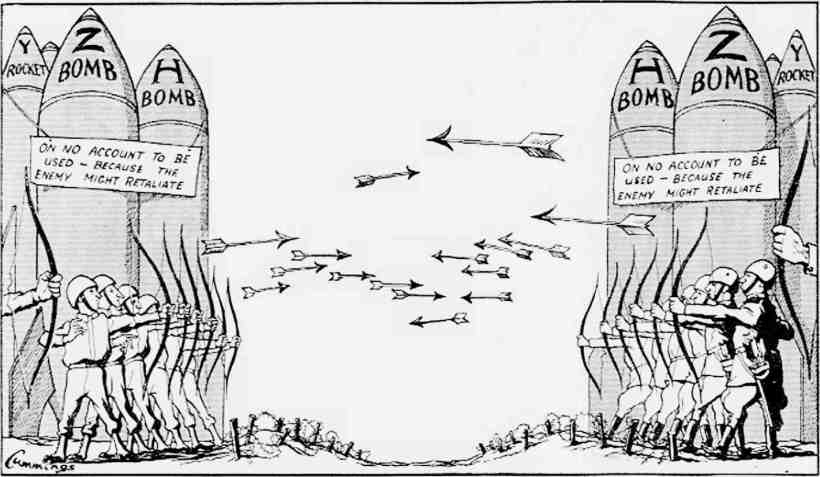
Hi Billy
Great post again! I was certainly able to visualize the shift from WWII to the Cold War with this very detailed post 🙂 I do have a few questions though, regarding your statement about the allies not having been allies in the first place, what is your opinion about events such as the “percentages deal” between Churchill and Stalin? Was this a deception to gain the trust of Russia? Thanks !
Best Wishes,
Namuun
LikeLiked by 1 person
Hi Namuun,
First of all, I believe the Allies and the USSR joined arms in WWII because it was convenient to do so against a greater threat. Look at China for example, before Japan invaded, Chiang Kai Shek and the liberals were at civil war with Mao and his communists. However, once Japan invaded, they agreed to both fight Japan together first before continuing to fight each other. Hence, “the enemy of my enemy is my friend.” I think it is a similar situation for the Allies and USSR. Per your other question, I believe Churchill was fully intent on following through with his deal with Stalin. It was act/sign of cooperation even though Churchill did not like Stalin. But now you got me thinking… what if he did this because he expected Stalin would defy the deal and use it as a reason to further the divide between the West and East?? Historically speaking, Stalin again strategically played his hand and took full control of Eastern Europe. The world was too shocked by war to do anything about it especially Churchill’s England. Hope this helps.
Best,
Billy
LikeLike
Hi Billy,
Thanks a lot for your reply! You certainly changed my p.o.v there, I definitely did not think about the alternative intentions that Churchill had during those negotiations. Tnx again 🙂
LikeLiked by 1 person
Hey Billy,
Your blogs are very informative and easy to read! I was wondering what you think about the issue of western policy makers and their image of Stalin. Do you think if they would have truly understood his actions that the relationship during and after WW2 would have been any different? Or would it have not made much of a difference?
LikeLike
Hi Zoe,
Thanks for the compliment. Interesting question… since the failures of the White Army during the Russian Revolution (whom the West supported), I think the idea of even considering legitimate cooperation with Stalin was skeptical at best. The US in particular had a “Red Scare” in 1919 shortly after the end of the revolution. The distaste for communism was strong although its influence was going to become a inevitable reality. That being said, I doubt that if the western policy makers actually understood him, nothing would have changed. Stalin was paranoid, constantly changing his position on issues presented to him. He adapted and reassembled his hand in response to Western action. Therefore, because of this ability, the West could not legitimately understand his position on certain issues such as the Nazi-Soviet Pact. The only possible way I could see things turning out differently was if more Western leaders were realists and open to Soviet cooperation. The quote “the enemy of my enemy is my friend” could not hold more truth between the relationship of Stalin and the West. Progress seemed to be made in 1935 when the USSR joined the League of Nations, but quickly dissipated after the appeasement in Munich in 1938. Trust was non-existent and cooperation to defeat Hitler was of sole importance between Stalin and the West. I am kind of of talking in circles, but if the West did understand his purpose, and goals for the USSR during and after the war, they may had been able to anticipate what might have happened and prepared for it. The relationship itself would not have been better in my opinion. The Cold War was inevitable, one way or the other.
LikeLiked by 1 person